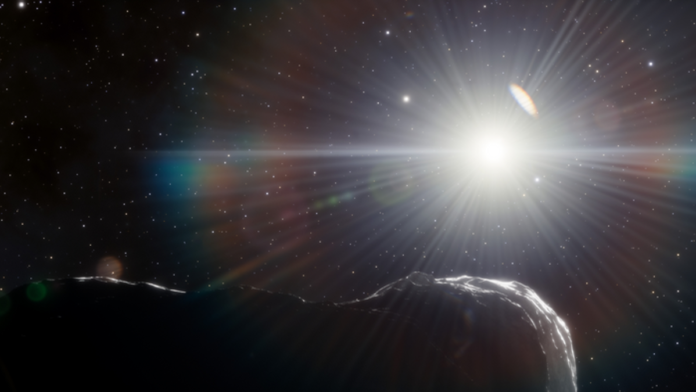Astronomers have spotted an asteroid in the glare of the Sun that is the largest object to be discovered in the last eight years and is ‘potentially hazardous’ to Earth.The study, published recently in The Astronomical Journal, found three new near-Earth asteroids (NEAs) hiding in the inner Solar System in the region interior to the orbits of Earth and Venus.Of these three space rocks, one is a 1.5km-wide asteroid called 2022 AP7 which has an orbit that could place it in the Earth’s path someday, say researchers, including those from the US National Science Foundation’s NOIRLab.The other two asteroids, they say, have orbits that remain interior to the Earth’s orbit and safely away from the planet.’Our twilight survey is scouring the area within the orbits of Earth and Venus for asteroids,’ study lead author Scott S Sheppard, from the Earth and Planets Laboratory at Carnegie Institution for Science, said in a statement. ‘So far we have found two large near-Earth asteroids that are about 1 kilometer across, a size that we call planet killers,’ he said.Astronomers say finding asteroids in the inner Solar System is a daunting challenge due to the glare of the Sun.To make these observations, they had to take advantage of brief, favorable conditions during twilight – a small 10-minute window each night.Apart from contending with the Sun’s glare, these observations are also close to the horizon, so astronomers have to peer through a thick layer of Earth’s atmosphere that can blur and distort what they see.’There are likely only a few NEAs with similar sizes left to find, and these large undiscovered asteroids likely have orbits that keep them interior to the orbits of Earth and Venus most of the time,’ Dr Sheppard said.’Only about 25 asteroids with orbits completely within Earth’s orbit have been discovered to date because of the difficulty of observing near the glare of the Sun,’ he explained.Scientists are yet to unravel more details on the potentially hazardous asteroid (PHA) 2022 AP7, including further details on the trajectory of its orbit as well as its composition. But for now, Dr Sheppard says it ‘will stay well away from Earth’, according to CNN.Research estimates that the minimum orbit intersection distance (MOID) of the asteroid to Earth was 0.0475 Astronomical Units (au). In comparison, 1 au is roughly the distance between the Earth and the Sun.MOID is a measure used to assess potential close approaches and collision risks between astronomical objects and is the distance between the closest points of the orbits of two bodies.’The Earth MOID for 2022 AP7 is only 0.0475 au, making it a PHA and likely the largest PHA found since 2014 based on absolute magnitude. 2022 AP7 is likely to be in the top 5 per cent of the largest PHAs known,’ the researchers wrote in the study.Researchers used the Dark Energy Camera (DECam) mounted on the Víctor M. Blanco 4-meter Telescope at Cerro Tololo Inter-American Observatory in Chile to make these observations.The state-of-the-art camera provided astronomers with the ability to capture large areas of the sky with great sensitivity.’DECam can cover large areas of sky to depths not achievable on smaller telescopes, allowing us to go deeper, cover more sky, and probe the inner Solar System in ways never done before,’ Dr Sheppard said.The findings, according to the scientists, also help unravel the distribution of small bodies in our solar system, and shed more light on how asteroids are transported throughout the inner Solar System. Scientists say the research also provides more insights on how gravitational interactions and the Sun’s heat contribute to the fragmentation of such space rocks.’Our DECam survey is one of the largest and most sensitive searches ever performed for objects within Earth’s orbit and near to Venus’s orbit. This is a unique chance to understand what types of objects are lurking in the inner Solar System,’ Dr Sheppard added.
Astronomers spot ‘planet killer’ monster asteroid – largest seen in last eight years
Sourceindependent.co.uk
RELATED ARTICLES


